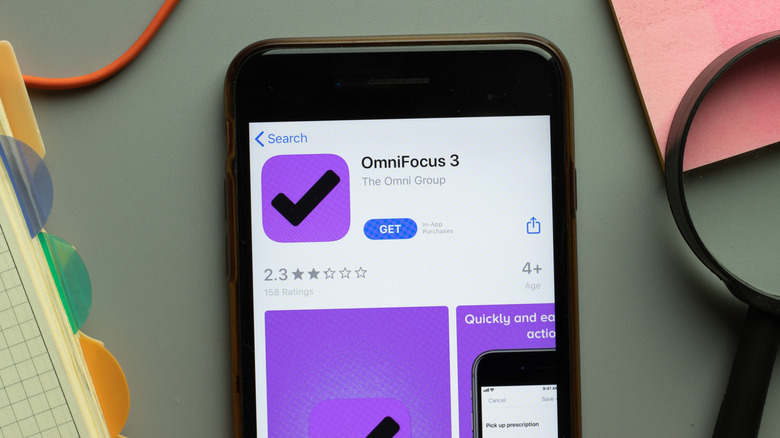Is The OmniFocus App Worth The Money?
Navigating a week without a to-do list can be as tricky as getting through a workday without coffee. According to Harvard Business Review, most people are dealing with an average of 15 tasks on a day-to-day basis, meaning that — unless you have a photographic memory — it's necessary to keep a record. Some planners report adding superfluous tasks to their to-do lists, enjoying the dopamine rush and lull in anxiety when items are crossed off. However, according to Huff Post via I Done This creators Janet Choi and Walter Chen, 41% of items on a to-do list are never completed. The problem? To-do lists don't differentiate between tasks that are quick-fixes (like changing a battery) and tasks that will take a whole lot longer — writing a 400-page novel, for instance.
In the past decade, technology has elevated the to-do list game. With virtual calendars, users can set reminders, list priority items, and effectively plan months in advance. OmniFocus was first launched in 2008 with the goal of "taming the chaos" of a busy professional life. But for all it has to offer, this service doesn't come without a price — $9.99 a month to be exact. So is the OmniFocus app worth the money?
OmniFocus is only available on Apple devices
According to OmniFocus, their to-do list software works as a "second brain." However, unlike most brains, OmniFocus doesn't get distracted or require breaks. It's also only available through Apple. Designed to work in conjunction with macOS and iOS, the OmniFocus app uses services like Siri for hands-free tasking and can integrate with your pre-existing notifications. According to Jonathan Sorum via Gizmodo, OmniFocus is "the single reason why [he] can't abandon iOS and go over to Android."
The app provides weekly reviews so professionals can preview upcoming or ongoing items, even those "someday, maybe" goals that may not be first-priority. OmniFocus also allows users to create distinctive categories — "work" and "personal," for instance — and allocate projects within those categories. For each action you can assign tags, specifying things like location, people, and even energy level.
For the many organizational features it offers, the OmniFocus App does not come without a price. A subscription costs $9.99 a month, according to PC Magazine. Customers also have the option to purchase the app for a one-time fee — $49.99 for the standard Mac or iOS app and $99.98 for a combo. For some, the price is unreasonable. According to one App Store reviewer, "I get why they need a subscription model to stay in business but I think $4.99 would be a much more reasonable price for what is essentially a reminders app (albeit [an] amazing reminders app)."
OmniFocus is built around getting things done
Productivity consultant David Allen trademarked the Getting Things Done philosophy (GTD), a methodology built around five steps: Capture, clarify, organize, reflect, and engage. According to Zapier, Omnifocus is based off of GTD, seeking to easily "capture" and effectively organize tasks based on priority. For instance, the app's custom "Perspectives" tool allows users to "sort and view just what you need, filtering out anything that's not relevant," according to one App Store reviewer.
However, OmniFocus isn't designed for collaboration, only individual tasking (via PC Magazine). If you're looking for a software that helps you organize team schedules and connect with colleagues, OmniFocus isn't for you. Services like Todoist and Asana are both cheaper alternatives that allow for collaboration and function independently from the Apple universe. As Wired reports in a 2021 article, OmniFocus recognizes that it isn't everyone's cup of tea. Customer support staffer April Ramm will recommend other to-do list softwares to customers whose work styles just don't align with GTD methodology. However, in a world where the traditional 9-5 workday is going extinct, OmniFocus is one of the best apps to help you sort through shifting priorities.


